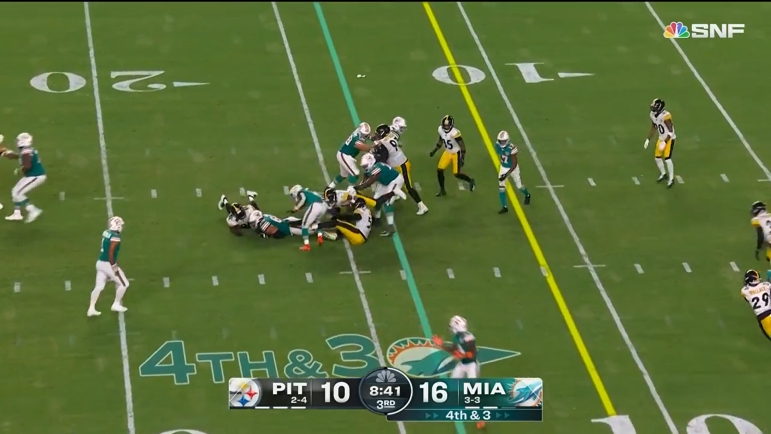There are several points in any game in which the tables could turn for better or worse, depending on the team’s perspective. That was certainly the case during Sunday night’s game between the Pittsburgh Steelers and the Miami Dolphins, with neither team managing to really capitalize on the turns of the tide in the second half—as evidenced by there being zero points scored.
Arguably Pittsburgh’s biggest moment, if not the final interception, was the illegal shift penalty on 3rd and 1 on the previous drive, which negated a successful conversion deep in Dolphins’ territory. The penalty pushed it to 3rd and 6, and then a holding call made it 3rd and 16, and then—interception.
The Dolphins failed to do much with that opportunity, however, much like the Steelers failed to light a spark under themselves following a key turnover on downs to start the second half. Head coach Mike McDaniel elected to go for it on 4th and 3, calling a run no less, from inside the 20. It was a 16-10 game, and a field goal would have made it a two-score game.
“I have a couple guys within analytics that are in my ear in all those types of situations. In this situation they did not advise me to go for it”, the first-year head coach admitted after the game regarding that play. The analytics did clearly favor kicking the field goal in that situation and taking the two-possession game of nine points rather than hoping to convert on 4th and 3 to try to make it a 13-point game, which is still under two full touchdowns’ difference.
McDaniel said that while he values analytics, the decisions are a “balancing act”, and he fully owned this particular decision. “I think at the moment I had some faith in the players and then regardless, you do it, and you don’t convert that’s a bad decision”, he said.
He did try to hedge, for some reason, arguing that it was closer to 4th and 2 rather than 4th and 3 and that the analytics are more favorable toward going for it on 4th and 2 rather than 4th and 3, which strikes me as silly.
Of course, it ultimately doesn’t matter, because his team won at the end of the day, sealing the game with interceptions to end each of the Steelers’ final two drives, both of which were threatening. Those are the plays Pittsburgh failed to make on its own end, and therein lay perhaps the key difference.
It’s a much easier pill to swallow since the Steelers didn’t manage to come back and win, but the decision exposed them to that possibility; had they kicked the field goal and gone up by nine, then a touchdown at the end of the game wouldn’t have changed the result. But then again, the Steelers didn’t even get the touchdown, let alone a field goal, and so here we are.








